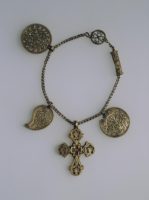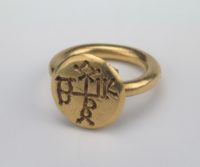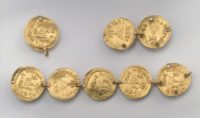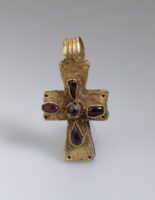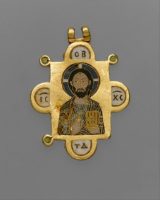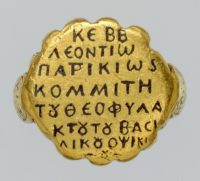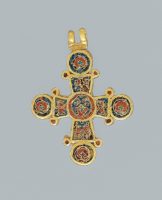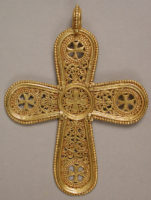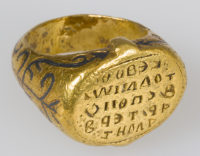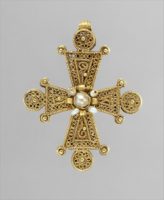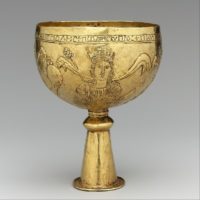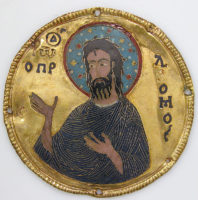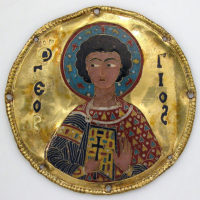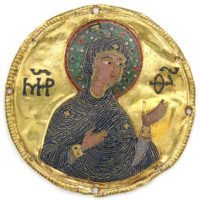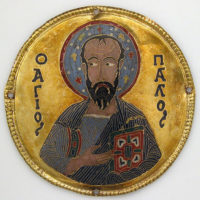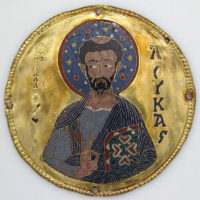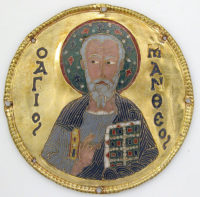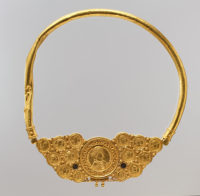Necklace, Period: Early Byzantine, circa: 6th century. Made in Constantinople. Material: gold. Technique: carving, engraving. Dimensions: Lenght 27 cm. The collection of the State Hermitage includes over 3 million works of art and world culture artefacts. It contains paintings, graphic works, sculptures, works of applied art, archaeological artefacts and numismatic objects. The Hermitage is considered to have been founded in 1764, when Empress Catherine the Great acquired an impressive collection of works from the Berlin merchant Johann Ernst Gotzkowsky. The museum celebrates the anniversary of its founding each year on 7 December, St. Catherine’s Day. Opening Hours: Tuesday, Thursday, Saturday, Sunday: 10.30-18.00 Wednesday, Friday: 10.30-21.00 Closed: Monday.
Ring Decorated with a Monogram, Period: Early Byzantine, circa: 7th century. Found: Pereshchepina Complex. near Poltava, the Village of Malaya Pereshchepina. Materials: gold. Technique: cast, polished, soldered and engraved. The collection of the State Hermitage includes over 3 million works of art and world culture artefacts. It contains paintings, graphic works, sculptures, works of applied art, archaeological artefacts and numismatic objects. The Hermitage is considered to have been founded in 1764, when Empress Catherine the Great acquired an impressive collection of works from the Berlin merchant Johann Ernst Gotzkowsky. The museum celebrates the anniversary of its founding each year on 7 December, St. Catherine’s Day. Opening Hours: Tuesday, Thursday, Saturday, Sunday: 10.30-18.00 Wednesday, Friday: 10.30-21.00 Closed: Monday.
Fragment of a Necklace Consisting of Eight Coins, Period: Early Byzantine. circa: Between 637 and 646. Found: Pereshchepina Complex. near Poltava, the Village of Malaya Pereshchepina. Material: gold. The collection of the State Hermitage includes over 3 million works of art and world culture artefacts. It contains paintings, graphic works, sculptures, works of applied art, archaeological artefacts and numismatic objects. The Hermitage is considered to have been founded in 1764, when Empress Catherine the Great acquired an impressive collection of works from the Berlin merchant Johann Ernst Gotzkowsky. The museum celebrates the anniversary of its founding each year on 7 December, St. Catherine’s Day. Opening Hours: Tuesday, Thursday, Saturday, Sunday: 10.30-18.00 Wednesday, Friday: 10.30-21.00 Closed: Monday.
Cross, Period: Early Byzantine, circa: 5th-6th century, Materials: golad and garnet. Dimensions: 3,8×1,9 cm. The collection of the State Hermitage includes over 3 million works of art and world culture artefacts. It contains paintings, graphic works, sculptures, works of applied art, archaeological artefacts and numismatic objects. The Hermitage is considered to have been founded in 1764, when Empress Catherine the Great acquired an impressive collection of works from the Berlin merchant Johann Ernst Gotzkowsky. The museum celebrates the anniversary of its founding each year on 7 December, St. Catherine’s Day. Opening Hours: Tuesday, Thursday, Saturday, Sunday: 10.30-18.00 Wednesday, Friday: 10.30-21.00 Closed: Monday.
Double-Sided Pendant Icon with the Virgin and Christ Pantokrator, Period: Middle Byzantine, circa: 1100. Made in Constantinople. Materials: Gold, cloisonné enamel. On view at The Met Fifth Avenue in Gallery 300. The Metropolitan Museum of Art (New York) is one of the world’s largest and finest art museums. Its collection includes more than two million works of art spanning five thousand years of world culture, from prehistory to the present and from every part of the globe. Public Hours: 10:30 a.m.–5:30 p.m. Open seven days a week.
Ring of Leontios, Period: Middle Byzantine, circa: 1000, Materials: Gold, niello, Inscribed: “Lord help Leontius, Patrician and Count of imperial Obsikion guarded by God”. The ring came from Leontios of the district of Opsikion, in exactly what is currently northwestern Turkey. Patrikios as well as komes were Roman titles that moved in definition throughout the Byzantine period; it promises that Leontios was the guv of the district or an upper-level general. On view at The Met Fifth Avenue in Gallery 303 . The Metropolitan Museum of Art (New York) is one of the world’s largest and finest art museums. Its collection includes more than two million works of art spanning five thousand years of world culture, from prehistory to the present and from every part of the globe. Public Hours: 10:30 a.m.–5:30 p.m. Open seven days a week.
Cross, Period: Middle Byzantine, circa: 1100, Made in Constantinople, Materials: Cloisonne enamel (red and blue). Dimensions: 15/16 x 7/8 x 1/8 in. (2.36 x 2.07 x 0.31 cm). On view at The Met Fifth Avenue in Gallery 303 . The Metropolitan Museum of Art (New York) is one of the world’s largest and finest art museums. Its collection includes more than two million works of art spanning five thousand years of world culture, from prehistory to the present and from every part of the globe. Public Hours: 10:30 a.m.–5:30 p.m. Open seven days a week.
Gold Cross Pendant, Period: Early Byzantine, circa: 500–700s. Material: Gold. Dimensions: 3 9/16 x 2 11/16 x 1/2in. (9 x 6.8 x 1.2cm). On view at The Met Fifth Avenue in Gallery 301. The Metropolitan Museum of Art (New York) is one of the world’s largest and finest art museums. Its collection includes more than two million works of art spanning five thousand years of world culture, from prehistory to the present and from every part of the globe. Public Hours: 10:30 a.m.–5:30 p.m. Open seven days a week.
Signet Ring of John, Imperial Spatharios, Period: Middle Byzantine, circa: 10th century, Materials: Gold, niello. On view at The Met Fifth Avenue in Gallery 300 . Museum Description: “The title spatharios, Sword-Bearer, was originally an honor reserved for the imperial bodyguard. By the middle Byzantine period, it had become an honorific title only, indicating Ioannis’s respectable status.” The Metropolitan Museum of Art (New York) is one of the world’s largest and finest art museums. Its collection includes more than two million works of art spanning five thousand years of world culture, from prehistory to the present and from every part of the globe. Public Hours: 10:30 a.m.–5:30 p.m. Open seven days a week.
Cross with Pearls, Period: Late Byzantine, circa: 1200–1400. Materials: Gold and pearls. On view at The Met Fifth Avenue in Gallery 303. The Metropolitan Museum of Art (New York) is one of the world’s largest and finest art museums. Its collection includes more than two million works of art spanning five thousand years of world culture, from prehistory to the present and from every part of the globe. Public Hours: 10:30 a.m.–5:30 p.m. Open seven days a week.
Gold Goblet with Personifications of Cyprus, Rome, Constantinople, and Alexandria, Period: Middle Byzantine, circa: 700s. Culture: Avar or Byzantine, Materials: Gold. On view at The Met Fifth Avenue in Gallery 301.
Museum description :“This goblet is decorated with female personifications of four major ecclesiastical centers in the Byzantine world. The awkwardly written identifications suggest that this goblet was an Avar attempt to imitate a Byzantine chalice.” The Metropolitan Museum of Art (New York) is one of the world’s largest and finest art museums. Its collection includes more than two million works of art spanning five thousand years of world culture, from prehistory to the present and from every part of the globe. Public Hours: 10:30 a.m.–5:30 p.m. Open seven days a week.
Medallion with Saint John the Baptist from an Icon Frame, Period: Middle Byzantine, circa: 1100, Made in Constantinople, Materials: Gold, silver, and enamel worked in cloisonné. On view at The Met Fifth Avenue in Gallery 303. The Metropolitan Museum of Art (New York) is one of the world’s largest and finest art museums. Its collection includes more than two million works of art spanning five thousand years of world culture, from prehistory to the present and from every part of the globe. Public Hours: 10:30 a.m.–5:30 p.m. Open seven days a week.
Medallion with Saint John the Evangelist from an Icon Frame, Period: Middle Byzantine, circa: 1100, Made in Constantinople, Materials: Gold, silver, and enamel worked in cloisonné. On view at The Met Fifth Avenue in Gallery 303. The Metropolitan Museum of Art (New York) is one of the world’s largest and finest art museums. Its collection includes more than two million works of art spanning five thousand years of world culture, from prehistory to the present and from every part of the globe. Public Hours: 10:30 a.m.–5:30 p.m. Open seven days a week.
Medallion with Saint George from an Icon Frame, Period: Middle Byzantine, circa: 1100, Made in Constantinople, Materials: Gold, silver, and enamel worked in cloisonné. On view at The Met Fifth Avenue in Gallery 303. The Metropolitan Museum of Art (New York) is one of the world’s largest and finest art museums. Its collection includes more than two million works of art spanning five thousand years of world culture, from prehistory to the present and from every part of the globe. Public Hours: 10:30 a.m.–5:30 p.m. Open seven days a week.
Medallion with the Virgin from an Icon Frame. Period: Middle Byzantine, circa: 1100, Made in Constantinople, Materials: Gold, silver, and enamel worked in cloisonné. The Metropolitan Museum of Art (New York) is one of the world’s largest and finest art museums. Its collection includes more than two million works of art spanning five thousand years of world culture, from prehistory to the present and from every part of the globe. Public Hours: 10:30 a.m.–5:30 p.m. Open seven days a week.
Medallion with Saint Paul from an Icon Frame, Period: Middle Byzantine, circa:ca. 1100, Made in Constantinople, Materials: Gold, silver, and enamel worked in cloisonné, On view at The Met Fifth Avenue in Gallery 303. The Metropolitan Museum of Art (New York) is one of the world’s largest and finest art museums. Its collection includes more than two million works of art spanning five thousand years of world culture, from prehistory to the present and from every part of the globe. Public Hours: 10:30 a.m.–5:30 p.m. Open seven days a week.
Medallion with Saint Luke from an Icon Frame, Period: Middle Byzantine, circa: ca. 1100, Made in Constantinople, Materials: Gold, silver, and enamel worked in cloisonné, Dimensions: Diam: 3 1/4 in. (8.3 cm) Mount: 20 1/2 x 15 x 7/8 in. (52.1 x 38.1 x 2.2 cm), On view at The Met Fifth Avenue in Gallery 303. The Metropolitan Museum of Art (New York) is one of the world’s largest and finest art museums. Its collection includes more than two million works of art spanning five thousand years of world culture, from prehistory to the present and from every part of the globe. Public Hours: 10:30 a.m.–5:30 p.m. Open seven days a week.
Medallion with Saint Matthew from an Icon Frame, Period: Middle Byzantine, circa: ca. 1100, Made in Constantinople, Materials: Gold, silver, and enamel worked in cloisonné, Dimensions: Diam: 3 1/4 in. (8.3 cm) Mount: 20 1/2 x 15 x 7/8 in. (52.1 x 38.1 x 2.2 cm), The Metropolitan Museum of Art (New York) is one of the world’s largest and finest art museums. Its collection includes more than two million works of art spanning five thousand years of world culture, from prehistory to the present and from every part of the globe. Public Hours: 10:30 a.m.–5:30 p.m. Open seven days a week.
The Fieschi Morgan Staurotheke, Period: Middle Byzantine, circa: early 9th century, Made in Constantinople, Materials: Gilded silver, gold, enamel worked in cloisonné, and niello. On view at The Met Fifth Avenue in Gallery 303. The Metropolitan Museum of Art (New York) is one of the world’s largest and finest art museums. Its collection includes more than two million works of art spanning five thousand years of world culture, from prehistory to the present and from every part of the globe. Public Hours: 10:30 a.m.–5:30 p.m. Open seven days a week.
Pectoral with Coins and Pseudo-Medallion, Period: Early Byzantine, circa: 539–50, Materials: Gold, niello, On view at The Met Fifth Avenue in Gallery 302. The Metropolitan Museum of Art (New York) is one of the world’s largest and finest art museums. Its collection includes more than two million works of art spanning five thousand years of world culture, from prehistory to the present and from every part of the globe. Public Hours: 10:30 a.m.–5:30 p.m. Open seven days a week.


